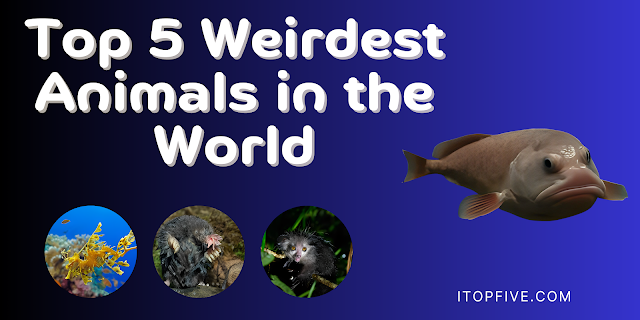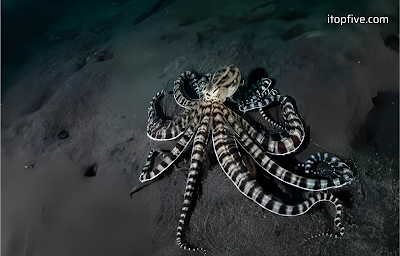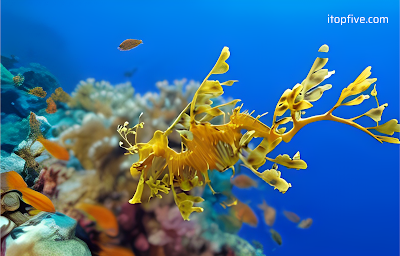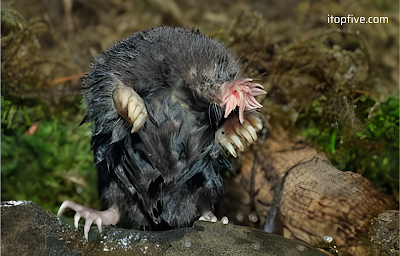Top Five Weirdest Animals in the World Overview
The animal kingdom is home to many unusual and different
species, some of which appear to be from other planets. Based on their
appearance, behaviors, and adaptations, this blog post will discuss the topfive strangest creatures in the world. These creatures' unusual characteristics
and ways of existence will astonish and captivate you.
1. The Mimic Octopus
The Mimic Octopus is a cephalopod found in the tropical and
subtropical waters of the Indo-Pacific region. It can imitate the look and
behavior of various species, including sea anemones, lionfish, flatfish,
crabs, and jellyfish. It accomplishes this by altering the color, texture, and
shape of its skin and how its limbs and torso are positioned. The mimic octopus
mimics other octopuses to avoid predators, trick prey, and communicate. A
brilliant creature, the mimic octopus, may pick up new mimics by watching other
animals. One of the world's most adaptive and flexible animals, the mimic
octopus is a master of disguise.
Key features of the mimic octopus animal are:
- The Indo-Pacific region's tropical and subtropical waters are home to this mollusk.
- It can mimic the features and behaviors of other species, including crabs, jellyfish, flatfish, lionfish, sea snakes, and even sea anemones.
- It accomplishes this by altering the color, texture, and shape of its skin and how its limbs and torso are positioned.
- It mimics other octopuses to communicate, deceive prey, and evade predators.
- Not only is it intelligent, but it can pick up new mimics from watching other animals.
- It is a master of deceit among the planet's most adaptive and versatile animals.
2. The Leafy Seadragon
The leafy seadragon is a fish in the same family as pipefish
and seahorses. It can be found throughout Australia's western and southern
coastline regions. Thanks to its long, slender body and leaf-like appendages,
it may blend in with the seaweeds and kelps. To help it navigate and maneuver
in the water, it also possesses a small dorsal fin and a pectoral fin. The
leafy seadragon eats by sucking in tiny crustaceans and plankton through its
long, tubular snout; it lacks teeth and a stomach. The leafy seadragon is one
of the few species in which the male carries the eggs. Up to 250 eggs are laid
by the female on the male's tail; the eggs are connected to a brood patch that
supplies nutrition and oxygen. After roughly two months, the eggs hatch, and
the baby seadragons are self-sufficient from birth.
Key features of the leafy seadragon animal are:
- It's a marine fish that shares a family with pipefish and seahorses. It is the sole individual inside the Phycodurus genus.
- It can be found throughout Australia's western and southern shores. It serves as the state's marine emblem and the main target of regional marine conservation.
- Slender body and leaf-like appendages may blend in with the seaweeds and kelps. It can also change color to fit in, but this ability depends on nutrition, age, environment, and stress level.
- It feeds by sucking in tiny crustaceans and plankton through its long, tube nose; it lacks teeth and a stomach.
- It uses its dorsal fin on its back toward the tail end and pectoral fin on the ridge of its neck to propel itself. The creature moves calmly through the water thanks to these tiny fins, nearly translucent and hard to perceive. They complete the appearance of floating seaweed.
- It is one of the rare creatures where the male carries the eggs. Up to 250 eggs are laid by the female on the male's tail, where they are connected to a brood patch that supplies food and oxygen. After roughly two months, the eggs hatch, and the baby seadragons are self-sufficient from birth.
3. The Star-Nosed Mole
The Star-Nosed Mole, a tiny mammal found in North America's
moist soils and wetlands, is called the star-nosed mole. Its unique nose, which
consists of 22 soft tentacles with thousands of sensory receptors apiece, is
formed like a star. The star-nosed mole is nearly blind. Therefore, it utilizes
its beak to feel and smell its surroundings. It is among the fastest foragers
in the animal kingdom, able to locate and recognize prey in less than a second.
To breathe underwater, the star-nosed mole also uses its nose to produce and inhale
air bubbles. The star-nosed mole can hunt on land and in water and is a
proficient swimmer and diver.
Key features of the star-nosed mole animal are:
- It is a small animal that is a member of the Eulipotyphla order, which also contains solenodons, hedgehogs, shrews, and moles.
- Its natural habitat is moist, low places in eastern North America, including peatlands, marshes, and areas with mixed and coniferous woods.
- Its unique star-shaped nose comprises 22 fleshy tentacles called Eimer's organs, each with hundreds of sensory receptors. The star-nosed mole is nearly blind; it utilizes its nose to feel and smell its surroundings.
- It is among the fastest foragers in the animal kingdom, detecting and identifying prey in less than a second. It consumes fish, mollusks, crustaceans, worms, and insects as food.
- By exhaling air bubbles and drawing them back into its nose, it is one of only two animals in the world that can detect scents underwater. The water shrew is the other animal.
- It features a long, hairy tail, broad forepaws with nails, and black fur. It's designed for swimming, diving, and digging. It can excavate shallow and deep burrow networks through marshy environments. It is also capable of swimming and water-based hunting.
4. The Blobfish
The Blobfish deep-sea fish that inhabits the oceans of
Australia and New Zealand is called the blobfish. It can levitate above the sea
floor with little energy because its gelatinous body is less dense than water.
Its face is human-like, with a big nose, small eyes, and a furrowed mouth; it
lacks muscles, bones, and scales. Crustaceans and other small animals that
float into their mouths provide food for the blobfish. There is a misperception
that the blobfish is the ugliest fish in the world. The blobfish appears normal
in its natural habitat, where high pressure preserves its body. But the
pressure decreases when it approaches the surface, causing its body to swell
and warp, making it a blob.
Key features of the blobfish animal are:
- This fish is a deep-sea species found in waters between 1,970 and 3,940 feet deep off the coasts of Australia and New Zealand.
- It can float above the sea floor with little energy because its gelatinous body is less thick than water. Its face is human-like, with a big nose, small eyes, and a furrowed mouth; it lacks muscles, bones, and scales.
- It consumes small invertebrates, such as crabs, that float into its mouth. Its large, tubular snout allows it to take in its meal because it lacks teeth and a stomach.
- Although it's a common belief, this fish is not the ugliest in the world. The blobfish appears normal in its natural habitat, where high pressure preserves its body. But the pressure decreases when it approaches the surface, causing its body to swell and warp, making it a blob.
5. The Aye-Aye
The aye-aye is indigenous to Madagascar. Its teeth are
constantly growing and resemble those of a rat, and it possesses a particularly
long, thin, skeleton middle finger. The aye-aye taps tree trunks and branches
with its finger to hear hollow sounds that mean grubs or insects are inside. It
then extracts the prey with its finger and consumes it. Additionally, the
aye-aye uses its finger to remove fruit and nut pulp. Some locals view the
aye-aye as a terrible omen, believing it may curse them by pointing its finger
at them. The aye-aye is threatened due to this belief, as well as habitat
degradation and killing.
Key features of the aye-aye animal are:
- It is the only surviving member of the family Daubentoniidae and a rare squirrel-like monkey found in Madagascar.
- Most aye-ayes are arboreal and nocturnal and live alone in the eastern Madagascar rainforests.
- Most aye-ayes reside east of Madagascar rainforests and are nocturnal, solitary, and arboreal creatures.
- It taps tree trunks and branches with its finger to listen for hollow sounds that suggest grubs or insects are inside. It then extracts the prey with its finger and consumes it. It also takes off the pulp from fruits and nuts with its finger.
- Some locals view it as a terrible omen, believing that by pointing its finger at them, it might curse them. The aye-aye is threatened due to this belief, as well as habitat degradation and killing.
Conclusion
These are the top five strangest creatures in the world
based on our criteria. They are all beautiful illustrations of the fantastic
and varied forms of life that nature can produce, each with its unique traits
and adaptations. We hope that you have enjoyed learning about these strange and
unusual creatures and that you will keep discovering and appreciating the
diversity of the animal realm.







